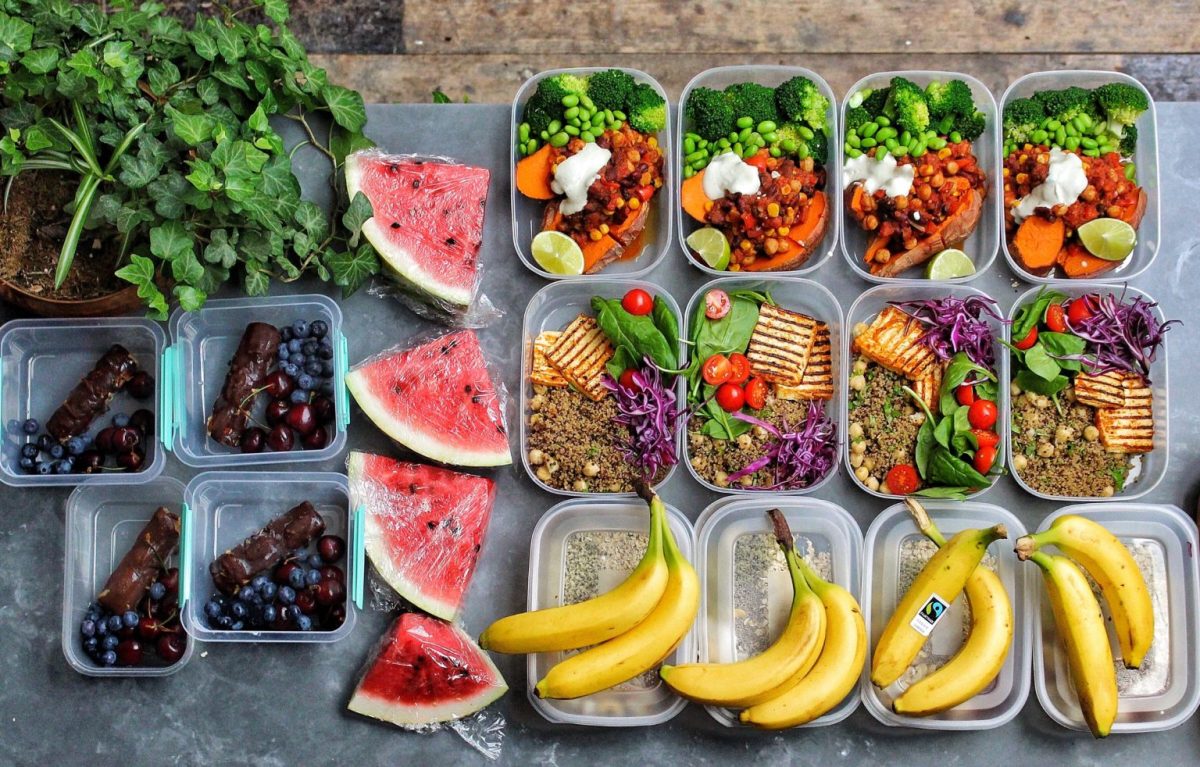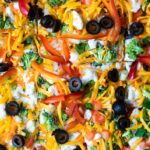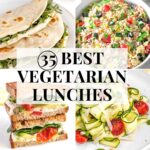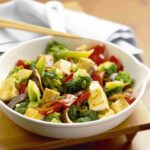Fuel your fitness journey with vibrant, delicious, and surprisingly protein-packed vegetarian meals! This guide unveils a world of high-protein vegetarian recipes designed to satisfy even the most dedicated fitness enthusiast. Discover a wealth of creative ideas, from power-packed breakfasts to energizing lunches and dinners, all crafted to maximize your muscle-building potential while adhering to a plant-based lifestyle. Prepare to transform your approach to vegetarian eating and unlock a new level of athletic performance.
We delve into the best vegetarian protein sources, providing detailed nutritional information and innovative ways to incorporate them into your daily meals. Learn how to strategically combine protein sources for optimal amino acid absorption and discover time-saving meal prep strategies to fit even the busiest schedules. We’ll also explore the role of protein supplements within a vegetarian diet, offering guidance on safe and effective integration.
High-Protein Vegetarian Sources

Fueling a vegetarian fitness journey requires a strategic approach to protein intake. Unlike meat-eaters, vegetarians need to be more mindful of combining various plant-based foods to ensure they receive all the essential amino acids their bodies need for muscle growth, repair, and overall well-being. This section details excellent vegetarian protein sources, their nutritional benefits, and creative ways to incorporate them into your meals.
Top 10 Vegetarian Protein Sources
The following table lists ten excellent sources of vegetarian protein, their protein content per serving (approximate values may vary depending on preparation and specific product), key nutritional benefits, and serving suggestions. Remember that portion sizes influence the total protein content.
| Name | Protein Content (approx. per serving) | Nutritional Benefits | Serving Suggestion |
|---|---|---|---|
| Tofu | 10-12g (100g) | Complete protein, good source of iron and calcium. | Stir-fried tofu with vegetables, crumbled tofu in tacos, baked tofu with teriyaki glaze. |
| Tempeh | 19g (100g) | Complete protein, rich in fiber and probiotics. | Grilled tempeh steak, tempeh bacon, tempeh in stir-fries. |
| Lentils | 18g (1 cup cooked) | High in fiber, iron, and folate. | Lentil soup, lentil curry, lentil salad. |
| Chickpeas | 15g (1 cup cooked) | Good source of fiber, iron, and magnesium. | Hummus, chickpea salad sandwich, roasted chickpeas as a snack. |
| Edamame | 18g (1 cup shelled) | Excellent source of protein and fiber, rich in vitamins and minerals. | Steamed edamame as a snack, edamame in stir-fries, edamame pasta. |
| Quinoa | 8g (1 cup cooked) | Complete protein, high in fiber and iron. | Quinoa salad, quinoa bowls, quinoa as a side dish. |
| Greek Yogurt (if including dairy) | 20g (1 cup plain, nonfat) | Excellent source of protein and calcium. | Greek yogurt parfait, smoothie base, dip for vegetables. |
| Spirulina | 4g (1 tablespoon) | High in protein, antioxidants, and vitamins. | Added to smoothies, sprinkled on salads, used in baked goods. |
| Chia Seeds | 4g (1 ounce) | High in fiber and omega-3 fatty acids. | Chia seed pudding, added to smoothies, sprinkled on yogurt. |
| Seitan | 25g (100g) | High protein content, chewy texture. | Seitan steaks, seitan stir-fry, seitan in sandwiches. |
Creative Meal Incorporation Ideas
Incorporating these protein sources into your meals requires creativity and planning. The following examples offer diverse ways to include each of the ten sources listed above. Remember to adjust portion sizes based on your individual caloric and protein needs.
Tofu: 1. Crispy pan-fried tofu cubes in a vibrant vegetable stir-fry. 2. Marinated and grilled tofu steaks served with a quinoa salad. 3. Creamy tofu scramble with spinach and mushrooms for a protein-packed breakfast.
Tempeh: 1. Crumbled tempeh added to a hearty lentil soup for extra protein and texture. 2. Marinated and baked tempeh “bacon” for a vegetarian twist on a classic. 3. Grilled tempeh skewers with bell peppers and onions, served with a peanut sauce.
Lentils: 1. Lentil shepherd’s pie with a sweet potato topping. 2. Lentil and vegetable curry served with brown rice. 3. Lentil loaf, a hearty and satisfying vegetarian main course.
Chickpeas: 1. Homemade hummus with whole-wheat pita bread and vegetables. 2. Chickpea and vegetable curry. 3. Spicy roasted chickpeas as a healthy and crunchy snack.
Edamame: 1. Steamed edamame pods sprinkled with sea salt. 2. Edamame added to a stir-fry for extra protein and vibrant green color. 3. Edamame incorporated into a pasta salad for a boost of protein and fiber.
Quinoa: 1. Quinoa salad with black beans, corn, and avocado. 2. Quinoa bowls topped with roasted vegetables and a tahini dressing. 3. Quinoa stuffed bell peppers with a flavorful filling.
Greek Yogurt (if including dairy): 1. Greek yogurt parfait layered with granola and berries. 2. Smoothie base blended with fruits and vegetables. 3. Used as a dip for vegetables or as a base for sauces.
Spirulina: 1. Added to green smoothies for a boost of protein and nutrients. 2. Sprinkled on salads or soups for a vibrant green color and added protein. 3. Incorporated into baked goods such as muffins or bread for a nutritional boost.
Chia Seeds: 1. Chia seed pudding, a healthy and delicious breakfast or snack. 2. Added to smoothies for extra fiber and omega-3 fatty acids. 3. Sprinkled on yogurt or oatmeal for added texture and nutrition.
Seitan: 1. Seitan steaks marinated and grilled or pan-fried. 2. Seitan strips in a stir-fry with your favorite vegetables. 3. Seitan used as a meat substitute in sandwiches or wraps.
Complete Amino Acid Profiles
Consuming a variety of plant-based protein sources is crucial for obtaining a complete amino acid profile. Unlike animal proteins, which typically provide all nine essential amino acids in sufficient quantities, many plant proteins are incomplete, meaning they lack one or more essential amino acids. By combining different plant proteins throughout the day or even within a single meal, you can ensure you consume all essential amino acids. For example, rice and beans, a classic combination, provide a complete protein profile. Similarly, combining lentils with quinoa or chickpeas with whole grains offers a balanced amino acid intake. Strategic food pairings ensure optimal muscle protein synthesis and overall health.
Recipe Ideas
Fueling your fitness journey with delicious and nutritious vegetarian breakfasts is key to maximizing your performance and recovery. These recipes are designed to be high in protein, keeping you feeling full and energized throughout your morning workout or busy day. They are also adaptable to suit various calorie needs, allowing for flexibility in your diet plan.
High-Protein Vegetarian Breakfast Recipes
These three recipes offer a diverse range of flavors and textures, all while prioritizing high protein intake for fitness enthusiasts. Each recipe provides a detailed breakdown of ingredients and steps, ensuring easy preparation even on busy mornings.
Savory Tofu Scramble with Spinach and Mushrooms
Yields: 1 serving
Prep time: 5 minutes
Cook time: 10 minutesIngredients:
- 1 block (14 oz) extra-firm tofu, crumbled
- 1 cup chopped spinach
- 1 cup sliced mushrooms
- 1/4 cup chopped onion
- 1 tablespoon nutritional yeast
- 1 teaspoon garlic powder
- 1/2 teaspoon turmeric
- Salt and pepper to taste
- 1 tablespoon olive oil
Instructions:
- Heat olive oil in a pan over medium heat. Add onion and sauté until softened, about 3 minutes.
- Add mushrooms and spinach; cook until wilted, about 5 minutes.
- Crumble tofu into the pan and cook, stirring frequently, until heated through and slightly browned, about 5 minutes.
- Stir in nutritional yeast, garlic powder, turmeric, salt, and pepper. Cook for another minute.
- Serve immediately.
Nutritional Information (approximate): Protein: 25g, Carbohydrates: 15g, Fat: 12g
Greek Yogurt with Berries and Chia Seeds
Yields: 1 serving
Prep time: 2 minutesIngredients:
- 1 cup plain Greek yogurt (high protein)
- 1/2 cup mixed berries (strawberries, blueberries, raspberries)
- 1 tablespoon chia seeds
- 1/4 cup chopped nuts (almonds, walnuts)
- Optional: 1 tablespoon honey or maple syrup (for added sweetness)
Instructions:
- In a bowl, combine Greek yogurt, berries, chia seeds, and nuts.
- If desired, drizzle with honey or maple syrup.
- Enjoy immediately or refrigerate for later.
Nutritional Information (approximate): Protein: 20g, Carbohydrates: 25g, Fat: 8g
High-Protein Oatmeal with Protein Powder and Fruit
Yields: 1 serving
Prep time: 2 minutes
Cook time: 5 minutesIngredients:
- 1/2 cup rolled oats
- 1 cup water or milk (dairy or plant-based)
- 1 scoop vegan protein powder (choose a flavor you enjoy)
- 1/4 cup chopped fruit (banana, apple, or berries)
- Optional: 1 tablespoon nut butter
Instructions:
- Combine oats and water/milk in a saucepan. Bring to a boil, then reduce heat and simmer for 5 minutes, or until desired consistency is reached.
- Stir in protein powder until fully dissolved.
- Top with chopped fruit and nut butter (if using).
Nutritional Information (approximate): Protein: 28g, Carbohydrates: 40g, Fat: 8g
Adjusting Portion Sizes for Calorie Needs
These recipes can be easily adjusted to meet individual calorie requirements. For example, to increase the calorie content, add more oats to the oatmeal recipe, more tofu to the scramble, or a larger serving of Greek yogurt. To reduce calories, simply decrease the portion sizes proportionally. Adding more vegetables to any of these recipes will increase volume and nutrients without significantly impacting calorie count.
Nutritional Profile Comparison
A comparison of the approximate nutritional profiles reveals that the High-Protein Oatmeal offers the highest protein content (28g), followed by the Savory Tofu Scramble (25g), and the Greek Yogurt with Berries and Chia Seeds (20g). The oatmeal also has the highest carbohydrate content (40g), likely due to the oats. The Tofu Scramble provides a moderate amount of carbohydrates (15g) and fat (12g), while the Greek Yogurt is relatively lower in fat (8g) and offers a balanced carbohydrate content (25g). Remember that these are approximate values and can vary depending on specific ingredients and brands used.
Supplementing Protein Intake (Vegetarian)
Maintaining sufficient protein intake is crucial for fitness enthusiasts, especially those following a vegetarian diet. Plant-based protein sources, while abundant and diverse, can sometimes fall short of meeting the higher protein demands of intense training. Protein supplements offer a convenient and effective way to bridge this gap, ensuring optimal muscle recovery, growth, and overall athletic performance. Choosing the right supplement and incorporating it strategically into a well-rounded meal plan is key to maximizing its benefits.
Protein supplements play a vital role in supplementing the protein intake of vegetarian athletes. They provide a concentrated source of essential amino acids, the building blocks of muscle protein, often exceeding the amount found in equivalent servings of whole foods. This is particularly important for individuals engaging in strenuous activities that lead to increased protein breakdown and a higher demand for protein synthesis. Supplementation allows for easier achievement of daily protein targets, leading to enhanced muscle recovery and growth. However, it’s crucial to remember that supplements should complement, not replace, a balanced whole-foods diet rich in fruits, vegetables, and whole grains.
Vegetarian-Friendly Protein Supplement Types
A range of vegetarian-friendly protein supplements cater to diverse dietary preferences and needs. Each type possesses unique characteristics regarding amino acid profiles, digestibility, and potential side effects. Careful consideration of these factors is essential for selecting the most suitable option.
- Soy Protein: Derived from soybeans, soy protein is a complete protein, meaning it contains all nine essential amino acids. It’s readily available, relatively inexpensive, and easily digestible for many. However, some individuals may experience digestive discomfort or have soy allergies. Imagine a rich, creamy texture similar to a milkshake, but packed with protein. One serving can easily provide 20-25 grams of protein.
- Pea Protein: Gained popularity as a hypoallergenic alternative to soy and whey. Pea protein is also a complete protein, although its amino acid profile might be slightly less optimal for muscle building than soy. Its mild flavor makes it easily incorporated into various recipes. Visually, it’s a pale green powder that blends seamlessly into smoothies or baked goods. A typical serving provides approximately 20 grams of protein.
- Brown Rice Protein: A hypoallergenic option, derived from brown rice, offering a good source of protein and fiber. It’s often less expensive than pea or soy protein. However, it’s not a complete protein, meaning it lacks some essential amino acids, potentially requiring combination with other protein sources for optimal muscle protein synthesis. Think of a light beige powder, easily incorporated into recipes for a subtle flavor enhancement and protein boost.
Incorporating Protein Supplements Effectively
Successful integration of protein supplements into a vegetarian diet demands careful planning and mindful consumption. Over-reliance on supplements while neglecting whole-food sources can lead to nutritional imbalances. The goal is to strategically use supplements to enhance, not replace, the nutritional value of a well-planned diet.
A balanced approach involves distributing protein intake throughout the day, combining supplements with whole-food protein sources for optimal amino acid absorption. For example, a post-workout smoothie could combine pea protein powder with berries, spinach, and almond milk for a complete protein and nutrient-rich recovery meal. Alternatively, brown rice protein could be added to overnight oats along with nuts and seeds, providing a sustained release of protein and energy throughout the morning. Remember to always consult a healthcare professional or registered dietitian for personalized advice tailored to your specific fitness goals and dietary needs. They can help determine the appropriate dosage and ensure you’re meeting all your nutritional requirements.
Embarking on a high-protein vegetarian diet doesn’t mean sacrificing flavor or convenience. This comprehensive guide empowers you to create delicious, muscle-building meals that are both nutritious and satisfying. From mastering the art of combining protein sources to streamlining your meal preparation, you’ll gain the knowledge and recipes to fuel your fitness goals with a vibrant and sustainable plant-based approach. Get ready to experience the transformative power of delicious, high-protein vegetarian cuisine!
General Inquiries
What are some common challenges vegetarians face in meeting their protein needs?
Vegetarians can sometimes struggle to consume enough protein due to lower protein density in many plant-based foods compared to meat. Careful meal planning and strategic protein source combinations are crucial.
Are all vegetarian protein sources equally effective for muscle building?
No, different plant-based proteins have varying amino acid profiles. Combining sources like legumes and grains, or using supplements, ensures a complete amino acid profile essential for muscle growth.
How can I ensure I’m getting enough iron on a high-protein vegetarian diet?
Iron absorption from plant sources is lower than from animal sources. Pair iron-rich foods (legumes, leafy greens) with Vitamin C-rich foods to enhance absorption. Consider a doctor’s advice if concerned about iron levels.
What are the best ways to store leftover high-protein vegetarian meals?
Proper storage is crucial. Allow meals to cool completely before storing in airtight containers in the refrigerator for up to 3-4 days or freezing for longer storage.


